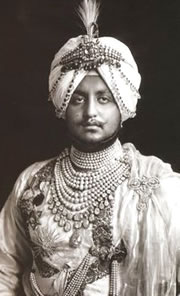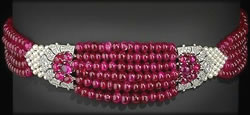|
Reviewed By Andreas Zabczyk
Jewels of the Maharajah of Patiala Maharajah Bhupinder Singh of Patiala in Dazzling Diamonds and Pearls
Patiala was a Sikh kingdom of Punjab, a state in Northwest India. Though he was not the first ruler, Maharajah Bhupinder Singh was the best known. He became Maharajah at the tender age of nine, was a keen cricketer with the best team in India and had the highest cricket ground in the area. He was also the first Indian to own a car and a plane. Said to have had a voracious appetite for food and sex, Maharajah Bhupinder Singh was known for his incredible jewels and apparently owned a breastplate necklace embellished with 1001 white diamonds. Yet, there were more opulent jewels to come. In 1889, Raja Bhupinder Singh bought a pale yellow 234.69-carat, octahedral diamond from the De Beers mine. In 1925, he sent a collection of loose gemstones to Cartier in Paris, where he requested a ceremonial necklace to be made. The Patiala Necklace was finished in 1928. It was an incredible piece of platinum jewelry that contained 2,930 diamonds, with a total carat weight of around 1000 carats and the yellow De Beers Diamond as its centerpiece. The Necklace was worn by Maharajah Yadavindra Singh (the son of Bhupinder Singh and last independent ruler before the formation of the Union of India) but later disappeared from the royal treasury. The Necklace resurfaced in an antique shop, from which Cartier bought the incomplete jewel back in 1998. There were many of the gemstones missing, so Cartier reassembled the piece using synthetic diamonds and cubic zirconia. The restoration was complete in 2002.  The Delhi Durbar Emerald Brooch
Another important historical piece of jewelry connected with the Maharajah and Maharani of Patiala is a diamond and carved emerald brooch which was presented to Queen Mary of England by Maharani Bakhtawar Kaur in 1911 on behalf of the ladies of India to celebrate the royal visit to India. This piece now belongs to the current British monarch, along with the Delhi Durbar Tiara and Necklace. The Necklace originally had two emerald pendants, one of which was changed at the request of the Queen to the Cullinan VII Diamond. An addional piece made by Cartier for the Maharajah was the Patiala Ruby Choker, which now belongs to the private Al-Thani Collection owned by Sheikh Hamad. It was displayed at the New York Metropolitan Museum of Art and the Victoria & Albert Museum in London. Arguably the most sumptuous ruby choker to be made, it was a stunning necklace fashioned from ruby beads, with platinum, pearls and white diamond accents. The rubies were mostly beads, strung with six strands at the front and five at each side.  The Patiala Ruby Choker
With minimal metal, the red color of the ruby beads bursts from the Choker. Raja Bhupinder Singh gave the Choker to one of his many wives and she wore the Choker above two other ruby necklaces, one of which was adorned with a large amount of ruby beads and ruby pendants. Like the Patiala Necklace, the Ruby Choker turned up in Europe much later. It had been shortened and made into a bracelet. Cartier repurchased the piece and restored it to its former glory. Though he was known for his lavish lifestyle, it seems that the indulgences of Maharajah Bhupinder Singh caught up with him, since he died at the age of just forty-six. He was survived by over fifty children and therefore has a great deal of descendants. His eldest son, Yadavindra Singh became the next Maharajah of Patiala. While the Maharajahs of India are no longer rulers of their kingdoms, their fantastic jewels will inspire many new creations. The Cartier "Tutti Frutti Hindu Necklace", which was commissioned in 1936 for Daisy Fellowes, drew inspiration from the colorful jewels of India. This will not be the last piece of jewelry designed after admiring the splendor of the Maharajahs. This Page in Other Languages
|
| STAY IN TOUCH | NEWSLETTER |
| *You're signing up to receive GemSelect promotional email. |
Copyright © 2005-2024 GemSelect.com all rights reserved.
Reproduction (text or graphics) without the express written consent of GemSelect.com (SETT Company Ltd.) is strictly prohibited.
2804